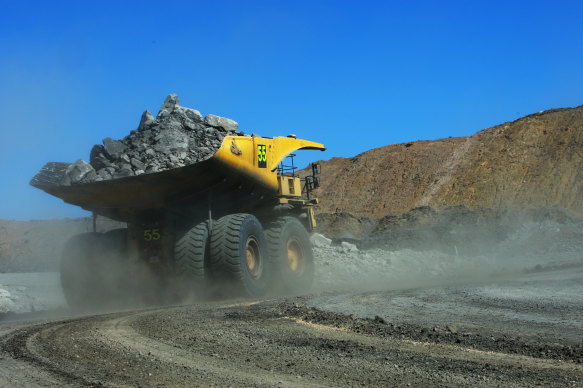
Save articles for later
Add articles to your saved list and come back to them any time.
Big, blue-chip Australian-listed companies outperform smaller ones, research has found, despite a long-held expectation that investors will be rewarded over the long term for the extra risk they take by investing in small companies.
Morningstar has measured the performances of the S&P/ASX Small Ordinaries index against the S&P/ASX 200, the index of the 200 largest Australian-listed companies by market capitalisation.
Unprofitable small listed Australian miners could be behind the returns of the small companies’ index lagging behind big companies’ index.Credit: Peter Braig
Both indices were launched in April 2000. An investor who had placed $10,000 in the small-cap index back then would have seen their investment go up to about $30,000, unadjusted for inflation.
If the $10,000 had been put into the large cap index it would have grown to about $60,000, or to twice as much, over the period. The returns are “total” returns, where the dividends of the investments are re-invested.
Callan Maclennan, an analyst at Morningstar, who carried out the research, says there are periods during the 23 years when the small-cap index did outperform, implying potential pockets of value can be added by the asset class.
However, the small companies index has generally delivered lower returns, with more volatility than for the S&P/ASX 200, which runs counter to the long-entrenched expectation of a small-cap premium for taking the extra risk, he says.
Investors have available to them exchange-traded funds (ETFs) with low fees, whose returns track or mirror the returns of a market index, such the large caps of the Australian Securities Exchange, as well as small caps, among others.
Index-tracking investing is known as passive investing and is distinct from active investing, where the fund manager buys and sells shares in companies with the promise that they can beat the market returns after fees.
“In Australia, passive investing in small caps is unlikely to constantly deliver the return premium that investors were perhaps expecting,” Maclennan says.
While the large companies are followed by many analysts, there can be opportunities for skilled fund managers to find hidden value, or potential for growth in small companies that are not as closely picked over by analysts.
The median-performing active small-cap manager on Morningstar’s database has beaten the S&P/ASX 200 in terms of average annualised compound returns over the past 10, 15 and 20 years.
However, the dispersion of the returns of active small-cap managers is large. One active manager beat the return of the S&P/ASX200 by almost 10 percentage points over the past 10 years.
The worst performer produced a return that was almost five percentage points less than the large cap index over the 10 years.
Maclennan says the implication of his research is that active management is likely to be a more suitable option for small caps than investing passively in the asset class, but that success depends very much on the manager selected.
There is a question over the quality of the Australian small-cap index itself, which has a large weighting to companies in the mining sector. Some of these are highly speculative and in the exploration stage.
Maclennan hopes to conduct further research into whether it is these speculative small companies that are the main reason for the underperformance of the small-cap index.
- Advice given in this article is general in nature and is not intended to influence readers’ decisions about investing or financial products. They should always seek their own professional advice that takes into account their own personal circumstances before making any financial decisions.
Expert tips on how to save, invest and make the most of your money delivered to your inbox every Sunday. Sign up here for our Real Money newsletter.
Most Viewed in Money
From our partners
Source: Read Full Article
